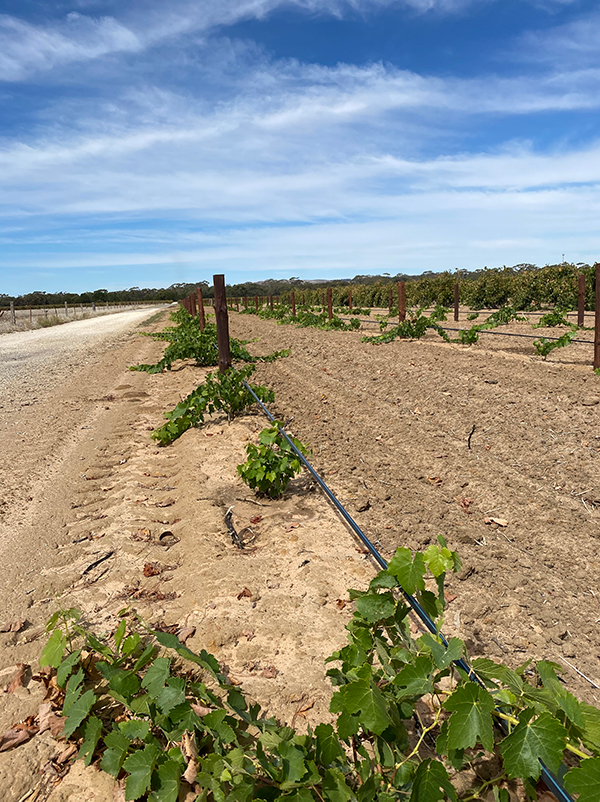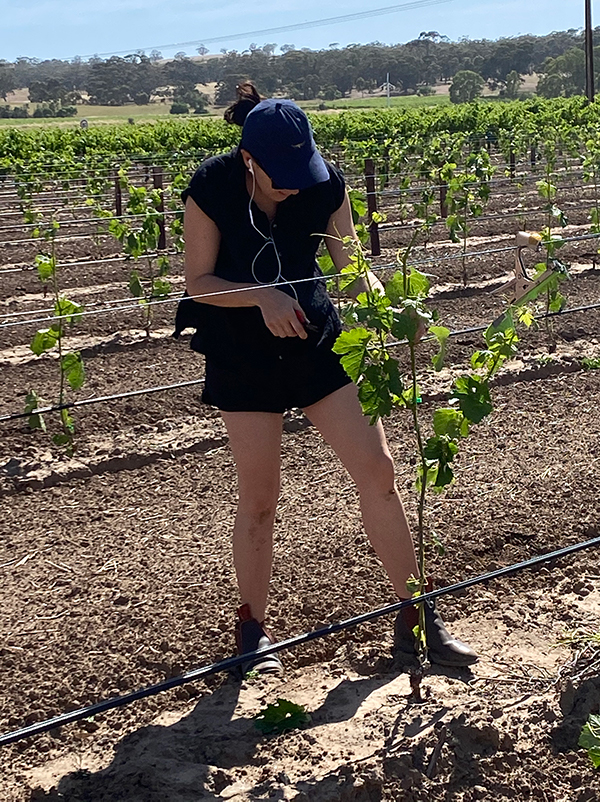When I was asked to write an article about the vineyard, this text came to mind: I am the vine; you are the branches. If you remain in me and I in you, you will bear much fruit; apart from me you can do nothing. John 15:5 (NIV)
I have been working in the vineyard for more than 40 years, together with my husband Wayne. In recent years, we have been joined by our son Corey and daughter-in-law Sarah and we now manage a joint operation.
Every grape grower develops the vineyard based on experience and practices learned over many years.
In our case, when we plant new vines, there are several steps that we follow. First, the soil is deep-ripped along the line that the vines will be planted. Then the area is planted with a cover crop of triticale which is a seed developed from a combination of wheat and rye. This helps to enrich the soil. Planting of the vine cuttings occurs in mid-September to mid-October. The soil is rotary-hoed to dig the cover crop in and, just prior to planting the vines, the ground where the rows will go is reworked.
The vine cuttings are purchased from a nursery where they have been tended after being grafted onto rootstock (wild vine). Root stock vines are chosen to suit the area where they will be planted. Once we receive the vine stick from the nursery we trim the new root growth back to a length of 10 to 12 cms and trim the top to leave two or three bud spurs.
Grafted vines remind me of God being the rootstock and we are the buds.
Time to plant
First, we lay out a specially marked wire with markings every three feet (90 cms) and this is strained tight to ensure a straight row. At each marker, a vine is planted. The water jet is poked into the ground at the marker and after the vine cutting is inserted, the topsoil is pressed firmly around the base of the vine to expel all air pockets from around the roots.
When planting is finished, it is then time to knock in the strainer posts at each end of the row and other posts along the row, one after every three vines. A wire is then strained low on the post to enable a dripper hose line to be attached. The dripper hose wire is stapled to the post and the dripper hose is tied onto the wire. When you do these jobs, you know where your back is! A top wire is then stapled to the top of the post and this becomes the training wire.
Time to train the vines
I am the true vine, and my Father is the gardener. He cuts off every branch in me that bears no fruit, while every branch that does bear fruit he prunes so that it will be even more fruitful. John 15:1,2
Training the vines properly is essential for producing a good grape crop. It can take three years for the vines to start producing a crop.
In the first year the vine bush is left to grow of its own accord. This is to allow multiple shoots to grow.
The second year, at pruning time, we look for the straightest shoot and prune it to a three to four bud spur. We cut through a bud to have a notch on top. When the vines start sending out shoots, a length of string is tied to the vine and then onto the training wire. The straightest shoot is chosen to attach the string and this shoot becomes the new vine. When this shoot reaches to the training wire, it is cut off about two cm above the wire. Then we leave four buds about 15 to 20cm below the training wire. These buds grow into shoots that are trained on the wire. One is wrapped on each side of the trunk and the third one is wrapped over the first one. The fourth shoot is cut back to the bud. All the other shoots and buds below this are cut out because we want the growth at the top of the new vine.
Training the vines is a rewarding job as we watch them grow. Every two to three weeks we go back and keep wrapping the shoots on the wire and removing any new shoots that have regrown.
Time to prune
At pruning time, we prune the new vine back to two rods (or canes). The third rod is cut back to a two-bud spur. One cane is tied to the right and the other to the left along the training wire. Thin wire is used to hold the canes on the training wire. It is always good to make sure that the vine is nice and straight. Then we watch them grow and start producing grapes. During the spring, up until about two months before grape picking starts, we spray the vines to stop disease.
Time for grape picking
Grape picking usually starts in late January or early February. When the grapes are looking like they are ready to pick, a sample of bunches is taken to the winery where they are tested for the Baume level. This refers to the sugar content of the grapes. When the wineries say it is OK to harvest, we pick our grapes with a self-propelled grape harvester. We employ two men to help with harvesting. We mainly pick the grapes at night when it is cooler.
There is a lot to know about grapes and how the wine is produced from them. Jesus used the illustration of the grape vine when teaching and we continue to learn his lessons as we work in our vineyard.




